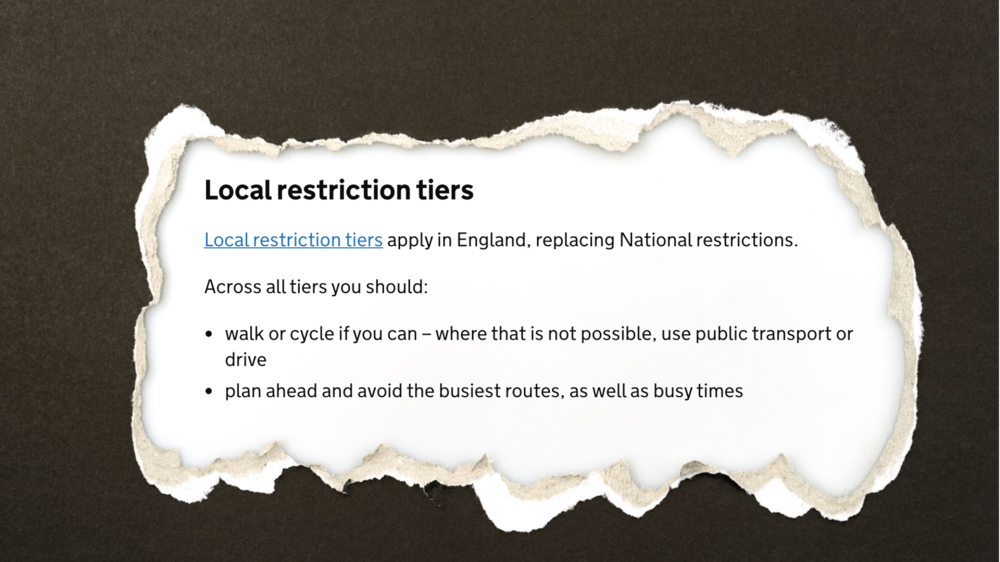7 days to save public transport
Last week, Simon Calder of the Independent dropped me a line. He asked if I’d seen the DfT’s latest movement stats from Monday. I hadn’t checked them , so he showed me.
It was scary.
With the end of “stay at home”, road traffic was back up to 78% of norm. Yet bus use outside London was 42%, while rail and tube use were stuck at 21 and 26%.
I don’t want to sound melodramatic, but this is something of an emergency for public transport, and only the Government holds the hammer that can break the glass.
Habits
Lockdown wasn’t a particular problem for public transport, other than the short-term revenue hole, as no-one can form new travel habits if they can’t leave the house.
But we’re now entering a dangerous territory in which cars have unlocked but public transport has not.
And the crescendo for this most dangerous moment occurs on the 12th April.
On the 12th April, it becomes legal for people to stay away from home.
All round the country, people will head off to visit family (well, their gardens, anyway), go on holiday and have a day trip. Life will start to feel normal.
The new habits people form then will stay with them, possibly for life.
So the fact that car use reviving at more than double the rate of public transport suggests that next week will be the moment in which millions form the habit of making journeys by car.
Covid isn’t the only killer
Covid is massively serious. It has killed 127,000 people. But the British Heart Foundation warns that 160,000 people will be killed by air pollution in the next decade on the basis of things carrying on as before. Inactive lifestyles kill 70-,000 people every year. And transport is Britain’s top cause of climate change.
The Government is in danger of sacrificing tomorrow’s lives for the sake of… well, for the sake of what? As there’s not that much evidence that public transport is Covid-dangerous.
I’ve already covered this in detail, so won’t repeat the arguments.
But what I will say is this: the dangers of a car-based recovery are huge.
If the Government genuinely believes that public transport is Covid-dangerous, then they shouldn’t be allowing travel by any mode. Better for everyone to stay local for a few more months than for dangerous new habits to form that will last lifetimes and kill more than Covid did.
If the Government doesn’t believe that public transport is Covid-dangerous, they need to say so – LOUDLY.
I expect the Government is intending to do what they did between lockdowns previously, and ride two horses.
It’s not what is said, it’s what is heard
If you look at the actual wording of the advice that applied last year, public transport was treated equally with car:
But no-one does look at the nuanced wording on a website: the message that has landed was the one contained in paid adverts like the one at the top of this page: public transport is not safe.
According to the latest Transport Focus research, just 37% of current non-bus users would feel safe making a bus journey.
Without massive, equivalent paid ad campaigns, these people aren’t going to be won back.
It won’t be easy. Last August, the Government did exactly what was needed for the hospitality trade. Paid adverts and high profile Ministerial visits to restaurants convinced the public that restaurants were Covid-safe (despite the combination of long customer dwell times in mixed household groups, the impossibility of face coverings, poor ventilation and lots of talking making restaurants one of the least Covid-safe spaces you can imagine). Restaurant use in August was greater than normal, helped by a big bung.
Who ordered the Covid?
It’ll be a harder sell this time. Having been convinced by the Government to Eat Out to Seed The Second Wave, the public will be more cynical.
But that’s all the more reason to try.
Equivalence
Did you see the Meghan Markle ruling last month?
No, wait, it’s relevant, hear me out.
A judge ruled that the Mail on Sunday needed to correct misinformation about the Duchess of Sussex not only by publishing a correction but by doing so on both the front page and on page three. Why? Because just publishing a correction won’t achieve anything: to change perceptions, the correction needs to be equivalent to the original message.
It’s the same with public transport: the Government landed the message that public transport is unsafe through ministerial briefings and paid ads. The correction needs to be equivalent to the original message.
The choice
In summary, these are the options:
1) Unlock without pro-public transport messaging and kill millions of people through air pollution, inactivity and climate change.
2) Unlock with public transport messaging.
3) Don’t unlock.
Which will it be?



